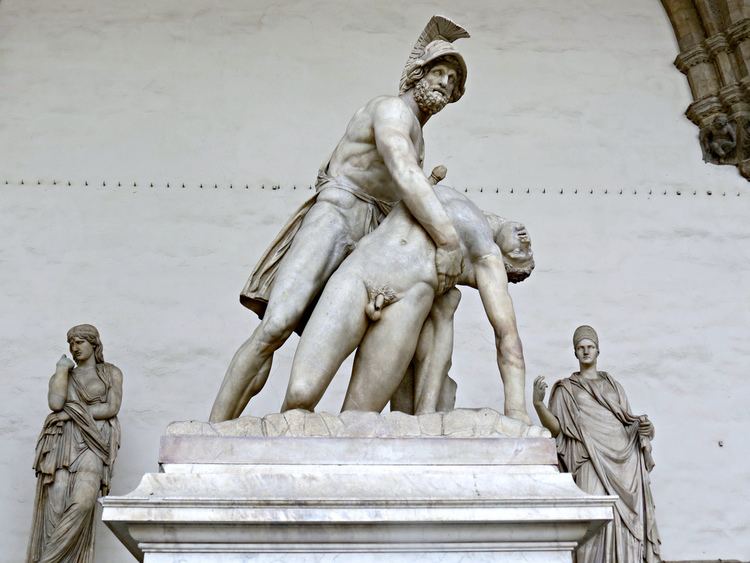Subject Patroclus, Menelaus | ||
 | ||
Similar Heracles and Nessus, Rape of the Sabine Women, L'Enlèvement de Polyxène, Perseus with the Head of, Hercules and Cacus | ||
Menelaus supporting the body of Patroclus (also known as the Pasquino Group) is a marble sculpture so-titled due to its apparent representation of an episode in the Iliad featuring the characters Menelaus and Patroclus. The sculpture has a complex artistic and social history that illustrates the degree to which improvisatory "restorations" were made to fragments of ancient Roman sculpture during the 16th and 17th centuries, in which contemporary Italian sculptors made original and often arbitrary and destructive additions in an effort to replace lost fragments of the ancient sculptures.
The ancient nucleus of the sculpture, underneath the later additions, initially consisted of the headless torso of a man in armor supporting a heroically nude dying comrade; the group was made in the late 1st century AD, a Roman copy freely reproducing a Hellenistic Pergamene original of the mid-3rd century BC. Another version of the composition, though so dismembered and battered that the relationship is scarcely recognizable at first glance, is the so-called Pasquin, the most famous of the talking statues of Rome. It was set up on a pedestal in 1501.
The sculpture now under the Loggia dei Lanzi in Piazza della Signoria, Florence, (illustration, right) is one of two modified versions of this subject that passed into the hands of Cosimo I, Grand Duke of Tuscany. (The other is in a subsidiary courtyard of Palazzo Pitti. Its history is briefly summarised below.)
The illustrated sculpture was purchased by Cosimo I, not long before 1570, soon after it was discovered in the vigna of Antonio Velli, half a Roman mile beyond Porta Portese, Rome. With the consent of Pope Pius V, it was taken immediately to Florence, where it appears in the inventory taken at Cosimo's death in 1574. The project for completing the truncated torso of the "Menelaus" figure, missing above the waist when it was found according to the Memorie (1594) of the sculptor and antiquarian Flaminio Vacca, was commissioned by Ferdinando II; the "restoration" was worked out by Pietro Tacca and executed by Lodovico Salvetti from Tacca's model, according to Filippo Baldinucci. It was set up in a niche on the south end of the Ponte Vecchio. Paolo Alessandro Maffei's engraving of 1704 shows that Menelaus then was wearing a helmet much simpler than the elaborate neoclassical one erroneously provided by Ricci seen on the sculpture today.
In 1771, the neoclassic artist Anton Raphael Mengs took moulds of the parts he considered genuinely ancient (and thus original) of this sculpture and the version at the Palazzo Pitti (discussed below) and reassembled them in a plaster model that was intended to be more faithful to the Roman original. It was taken away to be further repaired in 1798 and remained in obscurity, undergoing further adjustments by Stefano Ricci in the 1830s, until it was finally re-erected in 1838, in the Loggia dei Lanzi. The feature which still draws most attention is the lifeless hanging left arm of Patroclus, seemingly dislocated, which was in fact part of the Tacca-Salvetti restoration. Other errors in restoration are the lifted left leg of the bearer, the raised right knee of Patroclus, and the mounded ground that serves as a base.
The second Medici group
The second group of Menelaus supporting the body of Patroclus (not illustrated) was a gift in 1570 from the Florentine Paolo Antonio Soderini of Rome. It was said to have been found at the Mausoleum of Augustus. Identified as Ajax, is stands in the Cortile del Ajaco of Palazzo Pitti.
Further fragments of other Roman copies of this group have appeared during the 20th century, but more severe and careful modern criteria for restoration have led historians to avoid trying to restore them as a completed figural group, as past individuals attempted to do with Menelaus supporting the body of Patroclus.
